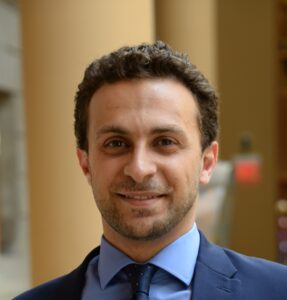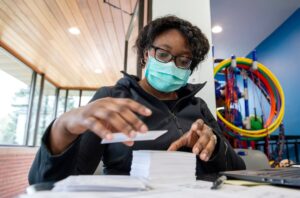
12
September

Through a collaborative pilot project, Associate Professor Olayinka Shiyanbola addresses disparities with new tool for primary care clinics
By Emma Gran
As health care resources quickly and heavily shifted toward COVID-19 testing and management in 2020, the primary care system struggled to meet the needs of Americans across the country, with access to many services delayed or diminished.
In April 2020, nearly 90 percent of primary care providers reported they were severely limiting regular check-ups and had growing concerns about unmonitored chronic conditions, reduced preventive care, and patient access to telehealth services.
The switch from in-person care to fully virtual communication introduced new barriers and consequences for two groups in particular: patients with chronic conditions and underserved communities. Technological limitations — such as lack of access to the internet, a computer or a smartphone — and struggles with digital and electronic health literacy have worsened pre-existing disparities in the management and prevention of chronic diseases.
“The clinics are the ones that need the tools to be able to reduce disparities,” says Olayinka Shiyanbola, associate professor in the Social and Administrative Sciences Division at the University of Wisconsin–Madison School of Pharmacy.
“When we do work around equity, we tend to focus on individuals but I think we need to step up and say it’s time for clinics to meet equitable standards for the patients they serve.”
—Olayinka Shiyanbola
“When we do work around equity, we tend to focus on individuals but I think we need to step up and say it’s time for clinics to meet equitable standards for the patients they serve,” she says.
An expert in health equity research, Shiyanbola is the co-investigator of a new project, funded by a pilot award from the UW Institute for Clinical and Translational Research, helping clinics develop strategies for delivering equitable care and prevent additional increases in health disparities.
The project, led by principal investigator Edmond Ramly from the UW School of Medicine and Public Health (SMPH), is engaging patients and health care team members to co-design a configurable, evidence-based tool to help clinics map local barriers to effective solutions and strategies for the prevention and management of chronic diseases. Using a systems engineering approach, the evidence-based tool will help clinics and patients address health inequities in their community.
Building the tool
Ramly, a health systems engineer with expertise in implementation science and human factors, Shiyanbola, and colleagues from medicine, nursing, and engineering — including Professor Elizabeth Cox and Associate Professor Kirsten Rindfleisch from SMPH — set out with a lofty goal: to build an effective, intuitive tool that can identify and provide recommendations for specific local barriers impacting primary care practice, while being generalizable enough to be used for a variety of clinic applications.

The tool is being constructed upon two frameworks widely established in the field of implementation science — the Consolidated Framework for Implementation Research (CFIR) and Expert Recommendations for Implementing Change (ERIC).
CFIR provides a guide for systematically assessing 39 known potential barriers to implementation while ERIC is a published compilation of 76 evidence-based implementation strategy terms and uses. The pilot study builds on a CFIR-ERIC mapping, which provides a list of ERIC-based strategies to consider based on CFIR-based barriers, prioritized by percentage of expert agreement.
The pilot study is bringing in a variety of local stakeholders at the individual, clinic, and organizational levels to participate in co-designing and building the tool. Ramly and Shiyanbola, and other faculty on the team will be using their input to personalize the CFIR-ERIC framework with information specific to primary care and sources of inequities in access to care.
“Essentially, we’re using both of these frameworks as the building blocks of our tool,” says Ramly. “In our co-design sessions with different stakeholder groups — patients, clinic staff and health system leaders — we are identifying barriers and strategy ideas in their own terms to design, modify and refine those evidence-based building blocks to make a tool that is practical, relevant, useful, and usable.”
For example, if a clinic seeks to improve their process for receiving patient feedback on quality of team-based care, the CFIR-ERIC matching tool will recommend the clinic implement tools for quality monitoring, use data experts, develop quality monitoring systems, and organize clinician team meetings.
“Tailoring the strategies requires several steps,” says Shiyanbola. “With the help of our stakeholders, we will be able to assess and understand determinants within the local context and adapt known intervention strategies to fit a clinic’s needs.”
The stakeholder sessions will focus on primary care in general but will specifically take up the rapid telehealth expansion and what new barriers that poses.
“For example, we’re hearing about barriers related to cardiovascular disease management, as well as diabetes, behavioral health, depression and a variety of other chronic conditions,” says Ramly. “We’re looking at this broader type of need — which is patients who need frequent contact with the health care team, frequent follow up, and often coordinated team-based care.”
“Talking to diverse collaborators and allowing for everybody’s voices to be heard introduces different angles and in the long run, will help us develop a better tool.”
—Olayinka Shiyanbola
When engaging organizational stakeholders at UW Health, UW Family Medicine, UW General Internal Medicine, and local federally qualified health centers, the researchers are focused on cataloging the barriers contributing to inequitable health outcomes in Madison.
“While it is always important to have a patient-centered perspective, having the clinics as stakeholders is equally as important when designing this tool,” says Shiyanbola. “Talking to diverse collaborators and allowing for everybody’s voices to be heard introduces different angles and in the long run, will help us develop a better tool.”
Development of the tool, which will function like an online menu, will continue for the next year. Then, it will be pilot tested in four local clinics.
“We want to take our time and make sure the tool has gone through a very rigorous process and is well-developed and tested before it is implemented in clinics beyond Madison,” says Shiyanbola. “Having a well-designed tool will hopefully help a lot of clinics map barriers to primary care in their locality and stop the increases in disparities.”
Equity expertise
As an experienced health disparities and equity researcher, Shiyanbola brings a critical health equity lens to this research.
“In my perspective, every researcher should always apply an equity lens to all work they do,” says Shiyanbola. “It may seem like a lot of responsibility to put on every researcher, but it’s so important to make sure your work will not worsen disparities.”

Shiyanbola has been conducting behavioral research in underserved communities in Wisconsin for years, particularly around chronic disease self-management. She was invited by Ramly to join the pilot project as an academic collaborator to ensure the work advances equity and maintains a patient-centered perspective.
“Shiyanbola’s depth and breadth of experience with health care disparities and engaging patients and stakeholders in designing interventions that meet their needs is of great value to this research,” says Ramly. He says he also brought her on the team for her experience with mixed methods research, medication adherence, and patient perceptions of their role in taking part in their own care.
Shiyanbola says she was excited to join the project and be involved in stakeholder engagement — which, according to Shiyanbola, is an integral part of any research that is frequently underutilized.
“I was ready to jump right in,” Shiyanbola says. “I knew the goals of this project would be beneficial to patients from diverse underserved communities, so I was excited to have the opportunity to be a part of it.”
Looking ahead
The next steps for this study include two concurrent directions — expanding the study’s breadth and depth
The team will take the research beyond Madison and leverage clinical data across more than 400 primary care clinics across 35 health systems in Wisconsin. They will also broaden their stakeholder engagement to include statewide partners like the Wisconsin Collaborative for Health Care Quality and the Wisconsin Research and Education Network — one of the nation’s largest and most widely respected primary practice research centers.
“Both of those organizations have a large number of primary care clinics that they work with across different parts of the state, so they are able to represent many, diverse perspectives,” says Ramly. “Their engagement will allow us to understand more about the barriers experienced across Wisconsin, building on our initial work both quantitatively and qualitatively,” says Ramly.
They also plan to increase the depth of the study by engaging with levels of leadership between top management and the clinical level to serve as bridges to the initial data that will power the tool.
“We want to keep engaging with stakeholders to uncover all the possibilities of this configurable tool to improve health outcomes in communities across Wisconsin.”
—Edmond Ramly
Ramly hopes these efforts will help his team identify ways to make the tool more useful in a variety of healthcare settings.
“This tool can be reused and leveraged for a variety of problems. For example, a strategy used to address barriers to managing cardiovascular disease could also apply to diabetes or substance abuse,” Ramly says.
According to Ramly, conversations with stakeholders have already identified additional uses for the tool beyond the original intention, such as operating as a baseline assessment to help clinics identify areas that need improvement, or to measure the readiness of an organization to implement a new service. It could also be employed as an ongoing, iterative assessment to help clinics determine how effective their current strategies are and address emerging barriers.
“There is so much potential for this tool,” says Ramly. “We want to keep engaging with stakeholders to uncover all the possibilities of this configurable tool to improve health outcomes in communities across Wisconsin.”




